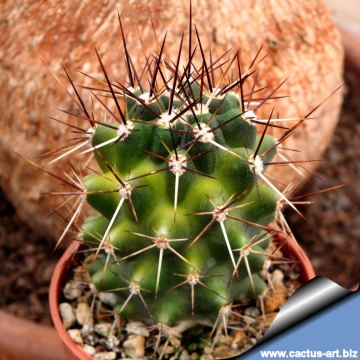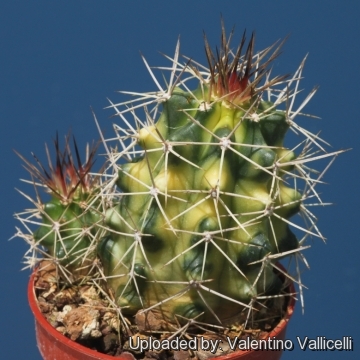
Echinocereus fendleri f. variegatus Photo by: Valentino Vallicelli
Origin and Habitat: Garden origin (Nursery produced cultivar)
Synonyms:
See all synonyms of Echinocereus fendleri
Description: Echinocereus fendleriSN|7149]]SN|7149]] is a low growing, scrubby cactus, that grows solitary or in small clumps with 5 to 20 stems. The classic fendleri form has huge violet-purple flowers and attractive white/black spination. The forma variegata has sectors, patches or stripes with pale yellow colours, even distinct shades of green. Plants with variegated stems are often attractive and highly prized. A very few variegated plants sprout unpredictably time by time among normal green seedling and are very rare. Variegated plants are also found in habitat even though with low frequency, but these plants are particularly sensitive and rarely survive in the harsh environment of their native land.
Stems: 10 to 30 cm tall, 5 to 7 cm in diameter somewhat flaccid ovoid to cylindric with age green with pale yellow zones .
Ribs: 9 to 13, with sinus between areoles.
Areoles: Circular areoles 8 to 17 mm apart.
Radial spines: 5 to 11 radials, 3 to 20 mm long, spreading, opaquely white.
Central spines: 0 to 3 darker, becoming lighter with age, rigid, straight or curved up to 4 cm long, porrect or ascending. In some areloes accompanied by short accessory centrals.
Flowers: Close to the stem tips, funnelform, 7 cm in diameter purple-violet, throat sometimes darker or purplish maroon. The stigma is green, and there is a very large number of stamens.
Blooming season: April to June.
Fruit: 2,5-5 cm long, 12 mm in diameter, edible, bright red, dull carmine, or purplish maroon, less often orange-tan or purplish orange, pulp magenta or red.
Subspecies, varieties, forms and cultivars of plants belonging to the Echinocereus fendleri group
Bibliography: Major references and further lectures
1) Edward Anderson “The Cactus family” Timber Press, Incorporated, 2001
2) Nathaniel Lord Britton, Joseph Nelson Rose “Cactaceae: Descriptions and Illustrations of Plants of the Cactus Family” vol. 4 The Carnegie Institution of Washington, Washington 1923
3) James Cullen, Sabina G. Knees, H. Suzanne Cubey "The European Garden Flora Flowering Plants: A Manual for the Identification of Plants Cultivated in Europe, Both Out-of-Doors and Under Glass" Cambridge University Press, 11/Aug/2011
4) David R Hunt; Nigel P Taylor; Graham Charles; International Cactaceae Systematics Group. "The New Cactus Lexicon" dh books, 2006
5) A. Michael Powell, James F. Weedin “Cacti of the Trans-Pecos & Adjacent Areas” Texas Tech University Press, 2004
6) Del Weniger “Cacti of Texas and Neighboring States: A Field Guide” University of Texas Press, 1984
 Echinocereus fendleri f. variegatus Photo by: Cactus Art
Echinocereus fendleri f. variegatus Photo by: Cactus Art Echinocereus fendleri f. variegatus Photo by: Valentino Vallicelli
Echinocereus fendleri f. variegatus Photo by: Valentino Vallicelli Echinocereus fendleri f. variegatus Photo by: Valentino Vallicelli
Echinocereus fendleri f. variegatus Photo by: Valentino VallicelliSend a photo of this plant.The gallery now contains thousands of pictures, however it is possible to do even more. We are, of course, seeking photos of species not yet shown in the gallery but not only that, we are also looking for better pictures than those already present.
Read More... Cultivation and Propagation: Variegated cacti are regarded as choice and difficult in cultivation, but despite that many of them are relatively easy to grow. But be aware that they cannot tolerate prolonged exposure to direct sun light (especially during the hottest summer days), so grow them in half-shade or under filtered sun. They are sometime seen as grafted plants, but some of this colourful plants (those with some chlorophyll) are able to grow on their own roots and are priced by collectors.
Soil: Use mineral well-permeable substratum with little organic matter (peat, humus).
Watering: Water sparingly from March till October, and keep perfectly dry in winter, at temperatures from 5 to 15 degrees centigrade. (In general these plants are more tender and cannot endure freezing temperatures). In the rest period no high atmospheric humidity!!
Propagation: By seeds, grafting or cutting. Because the variegation is due to the presence of two kinds of plant tissue, propagating the plant must be by a vegetative method of propagation that preserves both types of tissue in relation to each other. A most common way way to cultivate this partially de-coloured cultivars is to graft them onto another cactus which has chlorophyll and which will provide sugar to the mutant scion. The chlorophyll containing bottom part of the graft, called the stock, can be any number of different columnar cactus species.
Remarks: Seeds from variegated parents often give raise to some variegated seedlings too.














